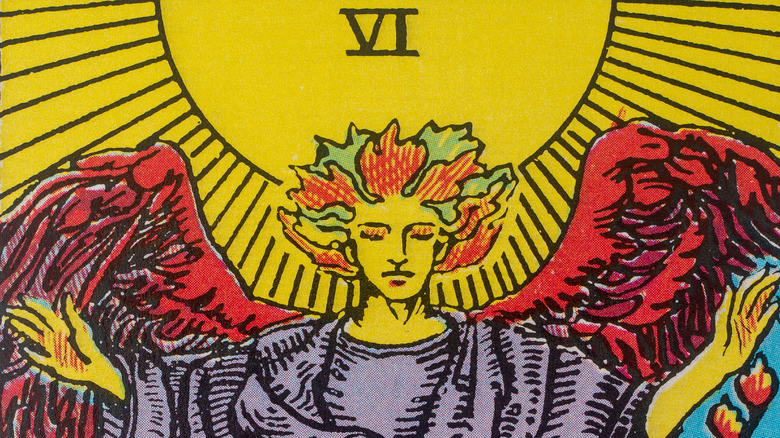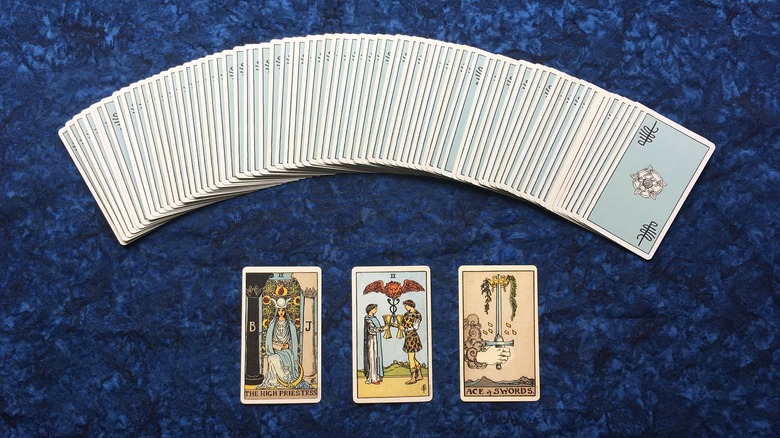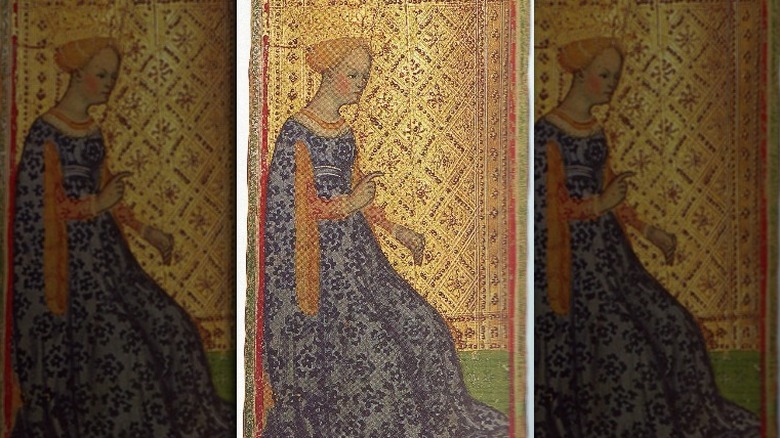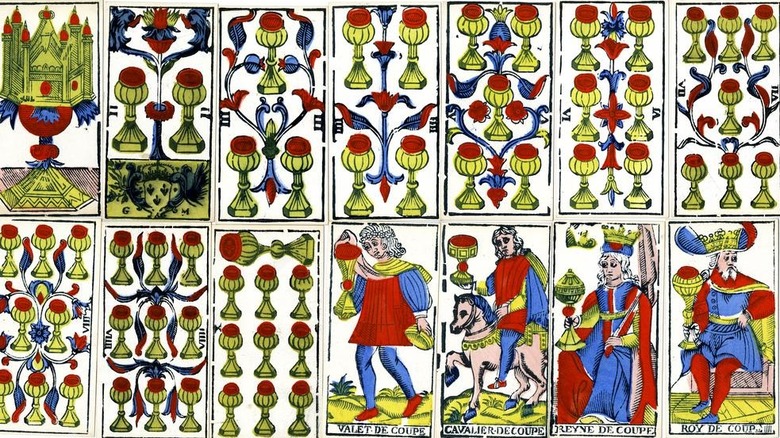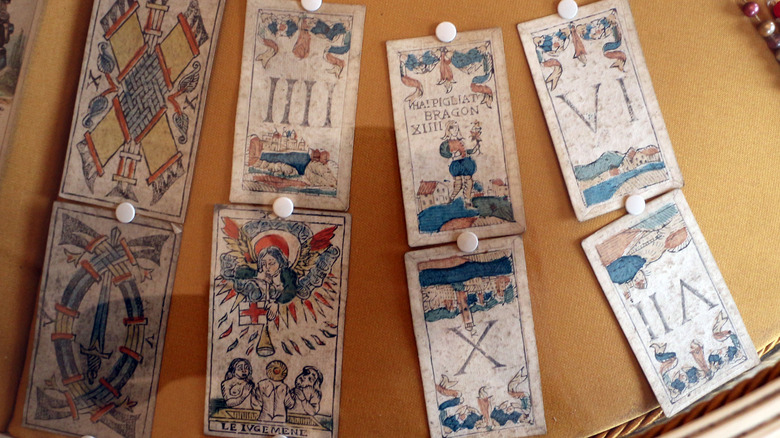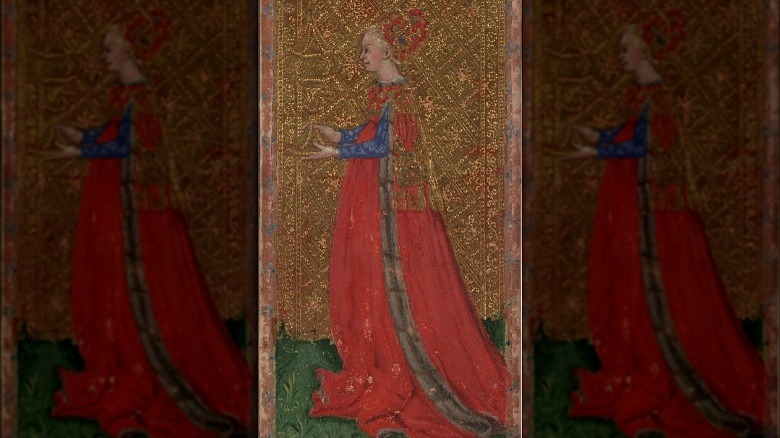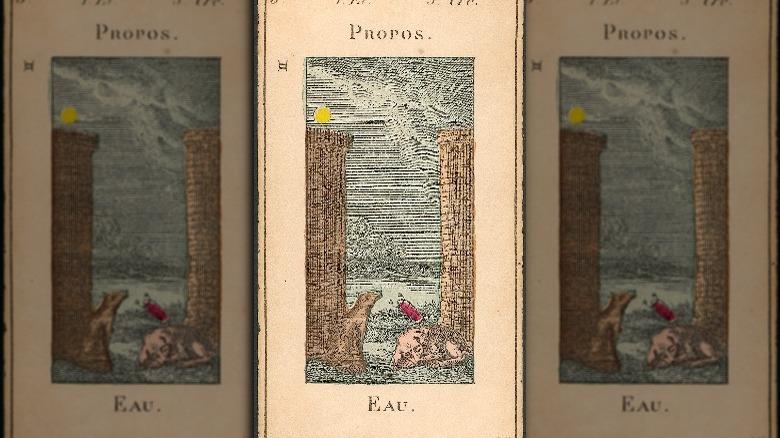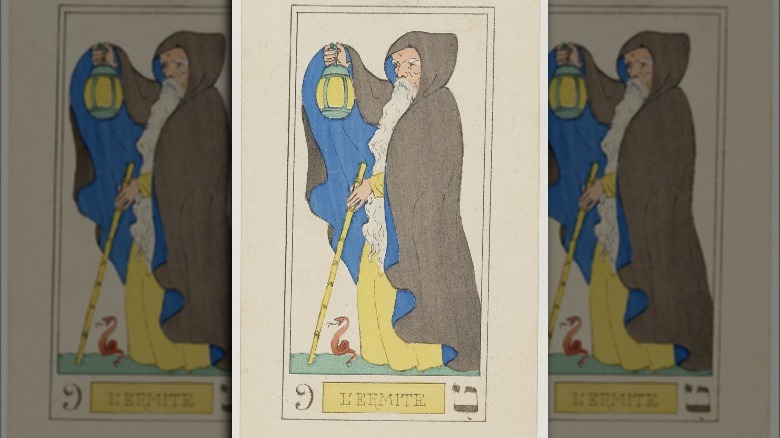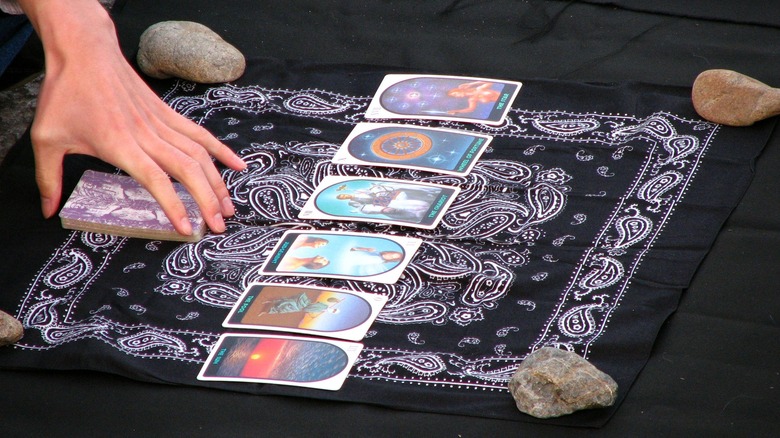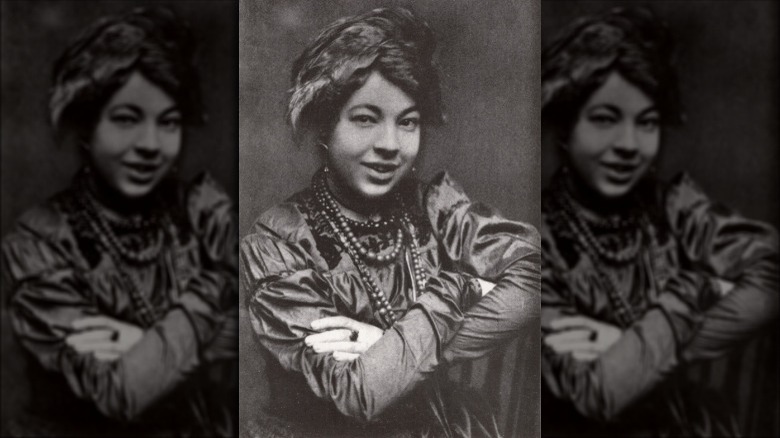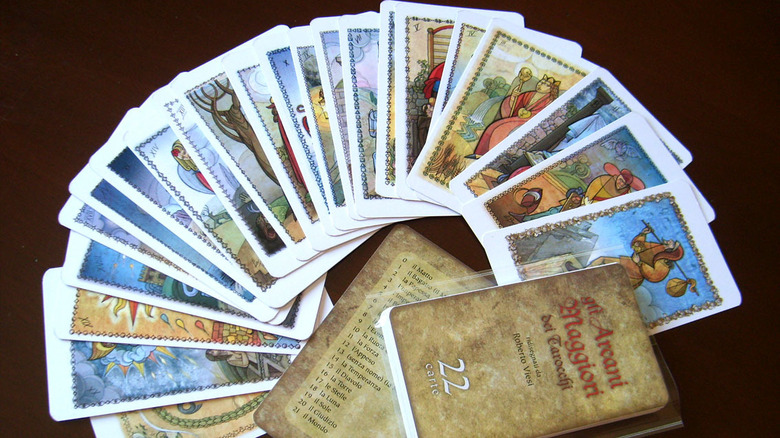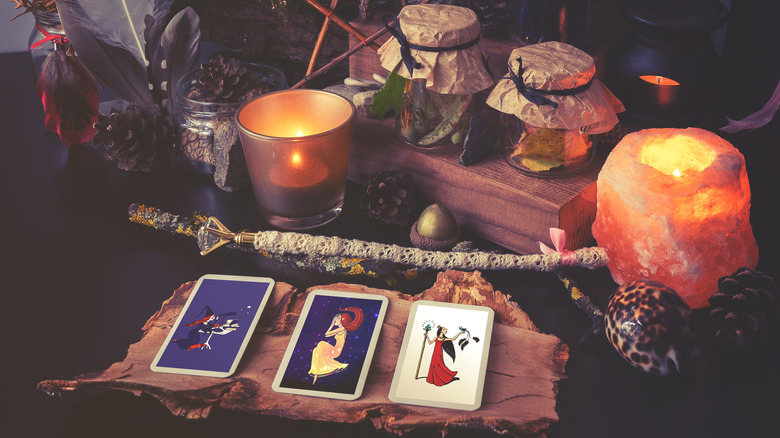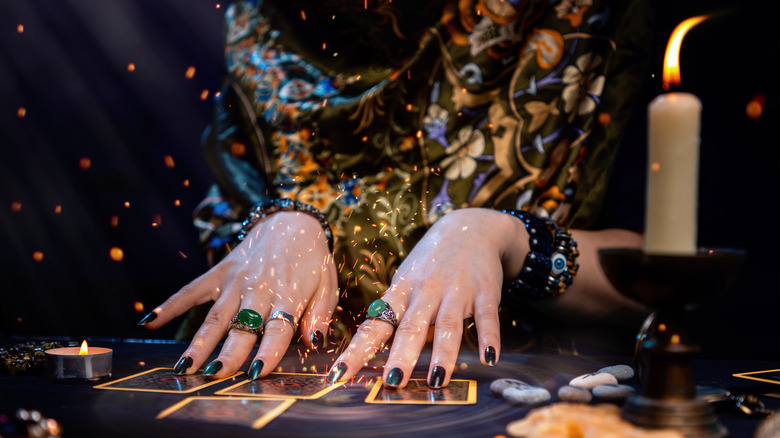The Untold Truth Of Tarot Cards
Step into a book shop or metaphysical store today, and chances are pretty good that you'll find a section, big or small, of tarot cards somewhere within those walls. And, if you dare to search for a deck of tarot cards on the internet, you'll be frankly overwhelmed with the variety of artistic and mysterious tarot cards that are available today. Then again, you might already have a deck or two on hand yourself. But why keep them around? Some people believe that tarot cards can be interpreted to tell the future, for one. Others use the cards as a self-reflective practice and yet more enjoy the rich imagery on the cards themselves, treating each deck as beautiful art objects.
But what is the actual history of tarot cards? Are they really mystical tools used to connect with a larger understanding of the universe, or merely pretty pictures? And where did they come from, anyway? The truth is that tarot cards, which Britannica reports have only really been around since the 15th century, have a pretty rich and complicated history. From the Renaissance inspirations behind the first tarot card decks to the proliferation of tarot today, there's quite a lot to dig into. This is the untold truth of tarot cards.
Tarot cards have a specific structure
Though there's plenty of variation when it comes to artwork and how they're used, tarot card decks that you see today typically share a similar structure. According to Britannica, it wasn't always strictly the way it is now, given that early tarot decks only had four suites. A fifth one, roughly representing what many modern people understand to be the major arcana, was added to the group in the early 15th century.
Most decks you'll encounter nowadays are based on early Italian tarot decks. All told, they'll have 78 cards. Those cards are further divided into the minor arcana of 56 cards, then the major arcana made up of the remaining 22 cards. The minor arcana has four suites that, for the careful observer, look an awful lot like the suites you see on a regular deck of playing cards today. Those include wands (equivalent to clubs), swords (spades), cups (hearts), and pentacles (diamonds).
Biddy Tarot notes that, in tarot, these suites are usually interpreted to represent different facets of someone's personality or life. Generally speaking, cups correlate to emotion, pentacles to finances, swords to thought and action, and wands to spirituality and energy. And, much like more generic playing cards, these suites have a jack, knight, queen, and king, in addition to lower numbered cards. As for the major arcana, notes Britannica, they tend to tackle large, overarching themes and forces and are also numbered (with the exception of the enigmatic fool card).
Tarot cards are not ancient
Though all of the talk of mysterious forces and mystical meaning could get you thinking that tarot cards have been around for a very long time, the truth is that they're a relatively new kid on the block as far as divination and card games are concerned. And, no, despite what some people with a touch of the Satanic panic might think, the first known tarot cards had very little to do with occultism or the Devil.
Tarot cards appear to have sprung up around the late 14th century in Italy. One of the earliest known decks was commissioned as a luxurious status symbol by the Visconti-Sforza family of Milan, according to Yale's Beinecke Rare Book & Manuscript Library. And the word "luxurious" isn't thrown around lightly here. The cards are all hand-painted, quite possibly by artist Bonifacio Bembo. Bembo, or whomever else painted the cards, created finely detailed figures that are offset by gleaming gold and silver paint (pictured).
While it could be that the Visconti-Sforza family occasionally broke out the deck for a round or two of games, the Morgan Library & Museum notes that this deck was very much a status symbol. The figures on the card — which are evenly split between men and women — features some richly attired figures, along more humbly dressed peasant types and a skeletal death card.
Tarot is linked to earlier Renaissance history
The now-classic imagery of Tarot cards may be linked to an actual history of Renaissance "triumph" parades. According to "The Tarot," this was a type of affair where each successive character in a procession outranks (or "trumps") the previous one. This was pretty irresistible for many artists of the time, who often used the imagery of a triumph in the ever-present allegories that often attempted to deliver a moralistic message. Some even lent a mystical air to their use of the triumph procession, with the final figure being the most enlightened of them all.
"The Fool's Journey" further claims that the cards were once known as "carte da trionfi," or "cards of triumph," directly linking the tarot cards of the time with this commonly understood visual device. After all, it had already been established by the time of ancient Rome, which loved a good triumphant procession with a god, emperor, or other big-name figure at the very end. By the time the Visconti-Sforza family and other Renaissance notables were putting down what were presumably large amounts of money for their decorative cards, the structure and import of the triumph procession would likely have been a common cultural language for many Europeans.
Tarot actually began as a secular card game
The earliest known set of tarot cards, the Visconti-Sforza deck, was created around 1440 and would have been used to play a game called "tarocchi," according to Slate. The game soon became popular throughout Europe, where other communities and cultures created their own variations. Eventually, somewhere in the south of France, the game became known as "tarot."
As to how people played tarocchi and its variants, it all depended on where you were sitting down at the gaming table. Per Britannica, some versions used all 78 cards, while others used a pared-down 58 instead. Ultimately, the goal is to gain the most points, as determined both by the value of the card itself and the move that involves a card. Some people can do so by teaming up, at least temporarily. Other games award extra credit for winning the final showdown with the lowest value trump card in one's hand. And, for central European players, it was often possible to gain yet more points if they announced their goal to complete a certain task ahead of time and actually did so.
For all purposes, tarot was solidly a game and a lighthearted form of entertainment until the 18th century. Even now, some people still play the game or one of its descendants, which include Sweden's vira, Germany's skat, or (perhaps more familiar to American players) the classic game of bridge.
Identifying the first tarot card artist gets tricky
Though it's clear that the earliest tarot cards were painted by someone, there are multiple candidates for the creator of the first identifiable tarot deck. According to the Beinecke Rare Book & Manuscript Library at Yale University, quite a few people attribute the early Visconti-Sforza deck to the work of fresco artist Bonifacio Bembo.
Yet, it's not as if Bembo signed his supposed work, so we don't exactly have a smoking gun when it comes to the art history of tarot. What's more, similarities and differences between key early decks make tracking down the original Renaissance artist all the more complicated. Perspectives on Tarot notes that there are actually somewhere in the neighborhood of 15 different tarot decks from the early to mid 15th century.
Given the geographical spread of who commissioned or received these decks, as well as the time that must have gone into painstakingly hand painting each card, it seems pretty unlikely that Bembo himself made each one. Even if artists in his workshop completed the lion's share of the painting, it's still a pretty tall order. Other painters who may have had a hand in creating some of the earliest Italian tarot decks include Francesco Zavattari, Antonio Cicognara, and Marziano of Tortona (the last of whom conveniently worked as Duke Filippo Visconti's secretary). Still, without any signatures, documentation, or clearly recognized chains of possession, it's unlikely that we'll ever know who designed the very first tarot deck.
The occult history of the tarot is kind of made up
As the Canadian Journal of Sociology reports, tarot cards didn't gain an occult reputation until the late 18th century, when people took the mostly neutral look of the playing cards and started assigning mystical and fortune telling meanings to them. Curiously, this was the same time period where the Enlightenment began to take over many parts of Europe, bringing a scientifically-minded and oftentimes secular worldview to many people. It could be, as the journal argues, that the mystical nature of tarot and other occult trends of the time were a sort of countertrend to the Enlightenment. That is, increasingly disempowered elites could have turned to a made-up occult history of tarot as a way of reaching back into the old world where they still held sway.
Or, it could have been people simply making up an interesting story and letting it get away from them. Mental Floss notes that increasing European interest in ancient Egypt in the late 18th century was part of this. For those who were unfamiliar with ancient Egyptian culture (which, in a time before the Rosetta stone, was darn near everyone in Europe), it was easy to link the imagery of tarot cards to a poorly understood mystical past. The esoteric Rider-Waite deck wasn't published until 1909 and didn't really get popular until much later, when a change in publishing rights pushed it to the forefront in the 1970s.
Later people tried to link tarot and Celtic culture
If you lived in the past and believed that tarot had a mystical pedigree, the idea of linking its imagery to your culture would be pretty tempting. That's just what happened to some in late 19th century Britain. As Folklore reports, this group of hopefuls attempted to draw a link between the trumped-up history of tarot and the Celtic past.
At the heart of many attempts to bring together Celtic culture and tarot was none other than King Arthur. Never mind that, to modern scholars, it seems pretty clear that Arthur is more of a literary figure than an actual, quasi-magical king of Britain's Dark Ages past. The idea that something like the cups suite in the tarot deck might be linked to the legend of Arthur's knights searching for the Holy Grail was, for some, just enough evidence to hint at a secret tradition that had been passed down through the ages.
Occultist A.E. Waite was especially instrumental in this movement, which lasted until about the 1930s. As such, the now ubiquitous tarot deck that sports his name, the Rider-Waite tarot, incorporates imagery tied back to his own quasi-Celtic interpretation of things. Waite, for instance, often referred to the different suits as the "Grail Hallows." Other writers claimed that the four suites corresponded to four objects mentioned in Grail stories — though not all the tales actually included four mystical things to line up so neatly with their interpretations.
Interpretations of the cards vary a lot
If you asked some tarot readers, they might tell you that the cards have an inherent meaning to them that can apply to a wide range of sitters and situations. Yet, they would be in the minority. In fact, it's far more common to have nearly as many interpretations of the cards as there are people to read them.
According to Mental Floss, some of the earliest tarot interpretations were deeply linked to Christian theology. When publisher Jean-Baptiste Alliette, who went by "Etteilla" (a reversal of his family name) put out his own interpretation of the tarot in 1791, he claimed that it was all linked to the mystical ancient Egyptian Book of Thoth, dedicated to the god of wisdom. He even put out his own deck to bolster that theory, drawing on 18th century interpretations of Egyptian symbolism. It appears to have been one of the very first tarot card decks published explicitly as a fortune-telling aid and Etteilla himself became one of the early proponents of occult tarot cards. Later decks included text providing more direct guidance, while some, like the Geografia Tarocchi deck from around 1725 provided scientific information alongside bits of mystical imagery.
Though some decks and individual readers stick to a pretty tried-and-true interpretation of tarot, many modern people who shuffle through a deck are just as likely to employ their own idiosyncratic take on the cards.
One of the most famous tarot decks does have an occult pedigree
While most scholars agree that the earliest tarot decks were meant to be used as games and status-conscious ways of keeping up with the medieval Joneses, later designers issued their own decks with occult agendas at the forefront. Jean-Baptiste Alliette did so in the late 18th century by drawing on half-understood mysticism courtesy of ancient Egypt (via Mental Floss). Many years later, a new deck took things even further. The Rider-Waite deck, named for the occultist A.E. Waite and publisher William Rider, was first put out in 1909. Alongside the cards themselves, Waite issued a book, "The Pictorial Key to the Tarot," that was meant to interpret all of the images in the highly detailed cards in a mystical context.
Its artist, Pamela Colman Smith (pictured), who was a member of the British occult group known as the Hermetic Order of the Golden Dawn, is often forgotten despite her pivotal role in the deck's development, Hyperallergic reports. Smith specifically created the imagery of the cards with occult symbolism in mind after Waite commissioned her to take on the project. Smith later converted to Christianity. However, the boundary-pushing Smith, who was a feminist, deep thinker, and clearly talented artist, never got the recognition or financial support to continue on as a successful and independent artist.
Tarot cards are popular again
Though tarot has pretty much always drawn people ever since its beginnings in Renaissance Europe, it's arguably experiencing a modern resurgence. A growing interest in reflective practices, mental health, and feminism has helped pave the way for tarot to rise again. As Chatelaine reports, that includes a variety of apps that give tarot card readings, dedicated boutiques, tarot parties, and increasing focus on "wellness" that prioritizes intuition and self-reflection.
What's going on here? Tarot card reader and author Daisy Waugh, speaking to The Guardian, points to a pervasive sense of loneliness and the sense that one is unmoored and drifting about in their life without the sort of social or cultural mores that both restricted previous generations and yet gave many an easy-to-follow path.
Tarot cards can allow people to think more deeply about their situation and perhaps even open up about some of their deepest vulnerabilities and desires. And, as the CBC reports, many more people now see tarot not as some external fortune-telling voice, but as a way to tap into their own personal interpretations of the mysterious imagery on the cards.
New tarot decks come out frequently
By now, tarot cards have a pretty deep and complicated history. And, as such, that means that many artists are interested in the challenge of creating their own decks with unique artwork and added significance. Some, as Atlas Obscura reports, are even considered masters of the tarot card-making craft. Artist Osvaldo Menegazzi is one such creator, working in Milan selling handmade decks with original artwork. For tarot enthusiasts, a visit to his shop, Il Meneghello, is surely a once in a lifetime opportunity.
Menegazzi isn't alone, however. Many other artists, oftentimes attracted by the opportunity include perspectives and peoples who have been ignored by previous tarot practices, are creating yet more modern tarot decks. Take the Tarot Mexicayotl, which artist David Romera uses to blend traditional Aztec imagery with the tarot's already mystical reputation. Then, there's Manzel's Tarot, a deck created by Manzel Bowman and which works with both mysticism and the sci-fi theme of Afro-Futurism (via It's Nice That).
Tarot is an irresistible storytelling tool for some
Though tarot is very much a visual medium, the broad themes and structure of tarot cards has been used by plenty of other creatives for years. And tarot themes show up in seemingly everything. Mythlore contends that even the ultra-popular "Star Wars" franchise can be read with tarot in mind, especially given that many of the films' larger themes tie in with both tarot and the broad mythological context established by cultural theorist Joseph Campbell in "The Hero with a Thousand Faces," which itself inspired filmmaker George Lucas.
For instance, the temptations represented by the Devil card certainly tie into the temptations faced by Luke Skywalker and even Darth Vader himself, with the hope that even the darkest figures can be redeemed. And the Moon, which often is taken to hint at the need for inner light and self-reflection, certainly sounds like it could be pointing towards the highly intuitive use of the Force.
Even Stephen King seems to have gotten in on the tarot action, according to Mythlore. His "Dark Tower" series of novels, which already draw pretty heavily on fantasy themes, also draws parallels to twin imagery in the tarot. Of course, King also plays with the idea of tarot, creating his own cards to build portentous imagery throughout the novels.
